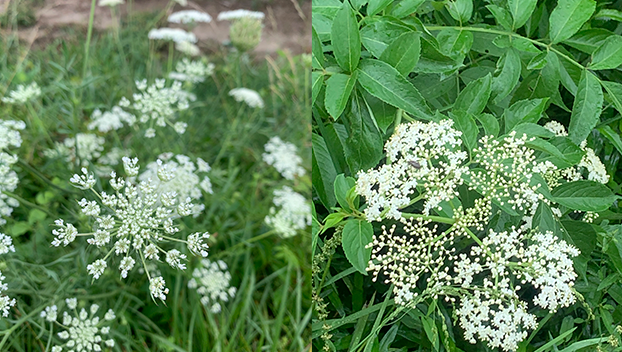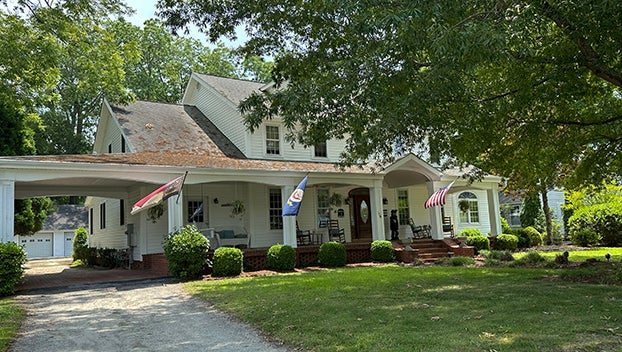Queen Anne’s Lace or Elderberry?
Published 11:47 am Thursday, July 1, 2021

- SPOT THE DIFFERENCE: The Queen Anne’s Lace flower (left) and the Elderberry flower (right) are often mistaken for each other. Both of these flowers can be found along roadsides throughout North Carolina. Elderberry is native to the area and the berries from these plants are used in a host of wellness products while Queen Anne’s Lace is considered an invasive species and is slightly toxic when consumed. (Photos submitted by Gene Fox)
|
Getting your Trinity Audio player ready...
|
I attended an engagement party a few weeks back that was planned and catered by The Acreage Events. It was a lovely affair, worthy of a spot in Garden & Gun magazine. Light fare and four drink stations behind a custom-made bar to keep you cool from the waning sunlight along the Pamlico. The decorations were the real prize winner though. Massive spreading arrangements that sprawled the length of the tables and seemed to be tall enough to touch the sky. As I looked at them, I noticed many of them had beautiful lacey flowers that seemed to float in their spot with a southern gracefulness.
This was Queen Anne’s Lace (Daucus carota). A beautiful biennial wildflower that grows wild in every one of the contiguous United States. It Is highly adaptable, as such it will thrive in a wide range of soils and levels of pH. This plant, also called Wild Carrot, belongs to the carrot family and has edible parts although the sap can be mildly toxic, causing skin irritations. The flower is an umbel, think of an upside-down umbrella unfolding that is three to four inches wide. The flower can be dipped in batter and fried like a funnel cake as a twist on a great treat. Although very beautiful, it is considered an invasive species in North Carolina. Queen Anne’s Lace is non-native, being introduced from Europe. It can be found along many roadsides and recently disturbed areas. It is not recommended to grow Queen Anne’s Lace in your garden because it is so invasive.
Often, Queen Anne’s Lace is confused by the untrained eye for American Elderberry (Sambucus canadensis). There are several species of elderberry but our native elderberry can be found along roadsides, ditch banks, creek sides, as well as recently disturbed moist areas. There are some major differences between these plants. Elderberry can grow nine to twelve feet tall. The flowers are borne to dense clusters resembling the umbel of Queen Anne’s Lace. Upon close inspection however, the flowers are a cyme. This is a broad, flat-topped inflorescence in which the flowers open from the center to the outer edges in order. A major difference between these two plants is the fruit. Between late June and August, elderberry will begin to display drooping clusters of deep purple colored fruit that resemble small grapes from a distance. These berries are often used to make syrups and elixirs that are thought to have medicinal uses that combat everything from the common cold to aging. However, the unprocessed fruit can be toxic to humans in large quantities. The Washington County Extension Center has made elderberry syrup and held classes on how to make it several times.
Elderberries have a very graceful flower, too. There are several improved cultivars that can be purchased to grow in the home landscape or garden, two of these are ‘Aurea’ and ‘Rubra’. They are mostly pest free, or as pest free as plants can be anyway. They will have a few issues with insect pests like aphids and spider mites which are not really classified as an insect. They are also susceptible to minor fungal diseases such as powdery mildew. They tolerate a wide variety of soils from wet to dry but prefer a moist, slightly acidic soil. Elderberry can be used as a hedge or around ponds and other natural areas to complete a landscape.
Water Hemlock (Cicuta maculata), is another native wildflower that looks similar to these two plants. The plant most resembles Queen Anne’s Lace with its white umbel inflorescence. It blooms later in the summer and into fall. This plant grows in wet meadows, thickets and freshwater swamps. Another major difference is that this plant is highly toxic if eaten. It has the power to cause seizures, tremors, convulsions, and even death.
I have had calls about all of these plants being Giant Hogweed (Heracleum mantegazzianum). If you remember a few years back, Giant Hogweed was in the National news as a major issue. The sap of this plant can cause severe burns on the body but it is important to note that all parts of the plant are toxic. These plants, especially Queen Anne’s Lace and Water Hemlock, can be confused with Giant Hogweed until one considers the size of the plants. Giant Hogweed is eight to fifteen feet tall with leaves that can be upwards of five feet and flowers that can be up to twenty inches in diameter. While there are a couple of infestations in North Carolina, they are managed intensively by NCDA&CS. NC State Cooperative Extension has multiple publications and factsheets on these plants. If you would like to learn more, visit our Extension Gardener Plant Toolbox (plants.ces.ncsu.edu) or take a look at our Weeds Portal (weeds.ces.ncsu.edu).
The next time you are out and about for a drive, take a look at the roadsides to see some of these plants. Our Eastern North Carolina wild beauty is unparalleled in this horticulture enthusiast’s opinion.
If you are having an issue in your home garden or landscape, send your questions to Gene Fox, Consumer Horticulture Agent with the North Carolina Cooperative Extension Service, please email Gene at gene_fox@ncsu.edu or call at (252)946-0111. Learn more on Facebook at the Blacklands Area Horticulture page or visit the Extension Office located at 155 Airport Road in Washington.
Gene Fox is the area consumer horticulture agent with North Carolina Cooperative Extension.





